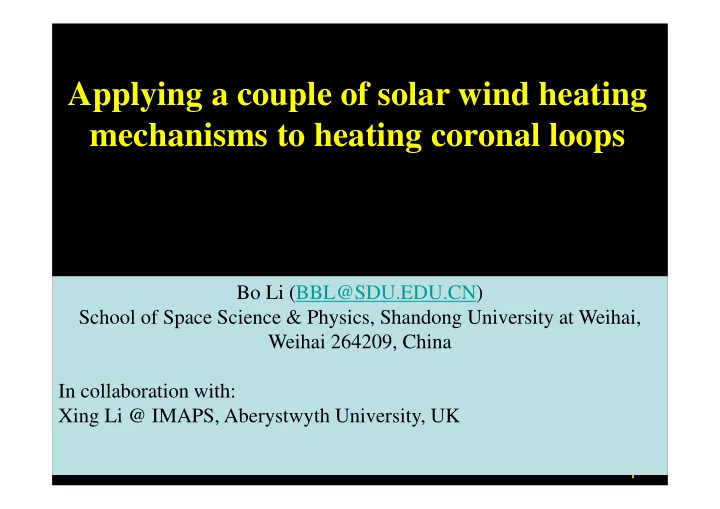

Applying a couple of solar wind heating mechanisms to heating coronal loops Bo Li (BBL@SDU.EDU.CN) School of Space Science & Physics, Shandong University at Weihai, Weihai 264209, China In collaboration with: Xing Li @ IMAPS, Aberystwyth University, UK 1
Applying a couple of solar wind heating mechanisms to heating coronal loops Outline � Motivations: from wind heating to loop heating � Models contrasted with TRACE and YOHKOH measurements � Summary 2
Observed ion temperature anisotropy ? significant ion temperature anisotropy + ions hotter than electrons 3
Solar wind heating mechanisms (to name but a few) parallel cascade (Hollweg 86, X. Li Ion- et al.99, B. Li et al.04, 05,11, Cyclotron among others) resonance (review by Hollweg & Isenberg spectrum sweeping (some heritage 02) from Axford & McKenzie 92; Tu & Marsch 97; X Li et al.03; He et al.08) Anisotropic turbulence (originated by Matthaeus et al. 99, developed into fluid model by Cranmer & van Ballegooijen 05, Cranmer et al. 07, 12 Verdini et al. 05, 10; Chandran et al. 11, Li & Habbal 12) 4
|| cascade 5
spectrum sweeping � basic idea: high-freq (kHz) waves launched by mag. recc. at chromospheric network, absorbed with distance as B decreases � put into a global fluid model model by Tu & Marsch 97 � can produce a TR + fast wind simultaneously (Li et al.03) 6
Do they apply to coronal loops? YOHKOH/ TRACE SXT 7
Words of caution � winds may be fundamentally different from loops – winds (collision-dominated → collisionless; TR heating often neglected; open tubes: there is no other end) – loops (collision-dominated; TR heating has to be an ingredient; closed tubes: both ends anchored to photosphere: discrete modes) � uncertainties exist as to – how turbulence cascades and dissipates – how to properly account for e - heat flux in TR � Aim of this presentation – present a direct contrast between observations and models constructed using solar wind heating mechanisms 8
Parallel cascade from Reale 10 LRSP 9
waves injected at one end wave amplitude 10 km/s (Chae et al.98) first developed by Li & Habbal 03; explored in O’Neill & Li 05; Li & Li 06; recently Xie & Li, manuscript 10
|| cascade: uniform loop A substantial flow of observed magnitude (~30-40 km/s) results only with asymmetric heating (Li & Habbal 03, Patsourakos et al.04) ∂ T ∂ T ∂ T 1 ∂ γ − 1 ∂ p p ( 1) ( ) 52 p + v + γ − T av − a κ T p e p ∂ ∂ ∂ κ ∂ ∂ t s a s n a s s e γ − 1 ( ) 2 0 + ν T − T + Q = pe p e κ n B 11
Dependence on base correlation length l 0 shocked loop static loop 12
An observational test YOHKOH/SXT TRACE data compiled by Winebarger et al.03 13
Does loop expansion help? loop expansion constrained by TR measurements (Patsourakos et al.99) black: uniform blue: w/ expansion � footpoint expansion amounts to momentum deposition, resulting in speed peaks 14
Dependence on base correlation length l 0 black: uniform blue: w/ expansion 15
Observational test again YOHKOH/SXT TRACE data compiled by Winebarger et al.03 black: uniform blue: w/ expansion 16
Does magnetic twist help? Li & Li 06 � kinetic energy flux; magneto+inertial centrifugal forces associated with azimuthal motion not important � twist reduces axial thermal conductivity, leading to higher temperature! 17
Does “waves from both ends” help? � two wave eqs. solved � amplitudes at ends chosen such that total fluc. ampl. agree with obs. � symmetric heating → static loops 18
Dependence on base correlation length l 0 black: uniform, single end blue: w/ expansion, single end green: w/ expansion, both ends 19
Spectrum sweeping Bourouaine et al.08 20
Does “waves from both ends” help solid: strong expansion dashed: weak expansion 21
Summary of preliminary results � A couple of solar wind heating mechanisms have been applied to heating coronal loops � Observational test shows parallel cascade help explain some Yohkoh/SXT loops, but not TRACE EUV loops – Magnetic twist won’t help – “Injection from both ends” won’t help � Spectrum sweeping may work – but TR heating should be more properly accounted for – but a detailed test needs to be done � Anisotropic turbulence – seems worth pursuing but z- and z+ should be properly treated – has yet to be incorporated into a fluid model – has yet to be tested observationally 22
BACKUP SLIDES 23
Anisotropic turbulence 24
Anisotropic turbulence van Ballegooijen et al.11 25
Recommend
More recommend